Disclosure: This article contains affiliate links. We may earn a commission from purchases at no extra cost to you, which helps our travel content.
Standing before the world's tallest uninterrupted waterfall after a challenging journey through Venezuela's Canaima National Park, I felt a familiar dilemma that's haunted me throughout my photography adventures: how does one possibly capture the magnificent scale and raw power of Angel Falls through a camera lens? After five visits to this natural wonder over the past decade—balancing my hotel management career with my photography passion—I've developed techniques that help translate this 979-meter cascade into images that convey at least a fraction of its majesty. This guide distills my experience photographing Kerepakupai Merú (the indigenous Pemon name for Angel Falls) into practical advice for fellow photographers seeking to document this bucket-list destination while respecting its cultural significance and fragile ecosystem.
Planning Your Angel Falls Photography Expedition
Photographing Angel Falls requires more logistical preparation than most destinations I've documented across five continents. Located in Venezuela's remote Canaima National Park, this UNESCO World Heritage site demands careful planning, especially for photographers carrying valuable equipment.
The journey typically begins in Caracas, followed by a flight to Canaima village, then a river journey and jungle trek. I recommend allocating at least 7 days for your expedition—anything less rushes the experience and limits your photographic opportunities. During my most recent visit last summer, I partnered with a specialized tour operator catering to photographers, which proved invaluable for accessing optimal shooting locations at ideal times.
While Venezuela has faced political challenges, the Canaima region remains a relatively safe haven for tourism. Still, I never travel to remote locations without comprehensive insurance coverage. My travel insurance has proven essential, particularly for covering my camera gear in such humid, unpredictable conditions.
Due to the region's remoteness, accommodation options near Angel Falls are limited primarily to eco-lodges and camps. I've found Jungle Rudy's Ucaima Camp offers the best balance of comfort and authenticity, with knowledgeable guides who understand photographers' specific needs regarding timing and locations.
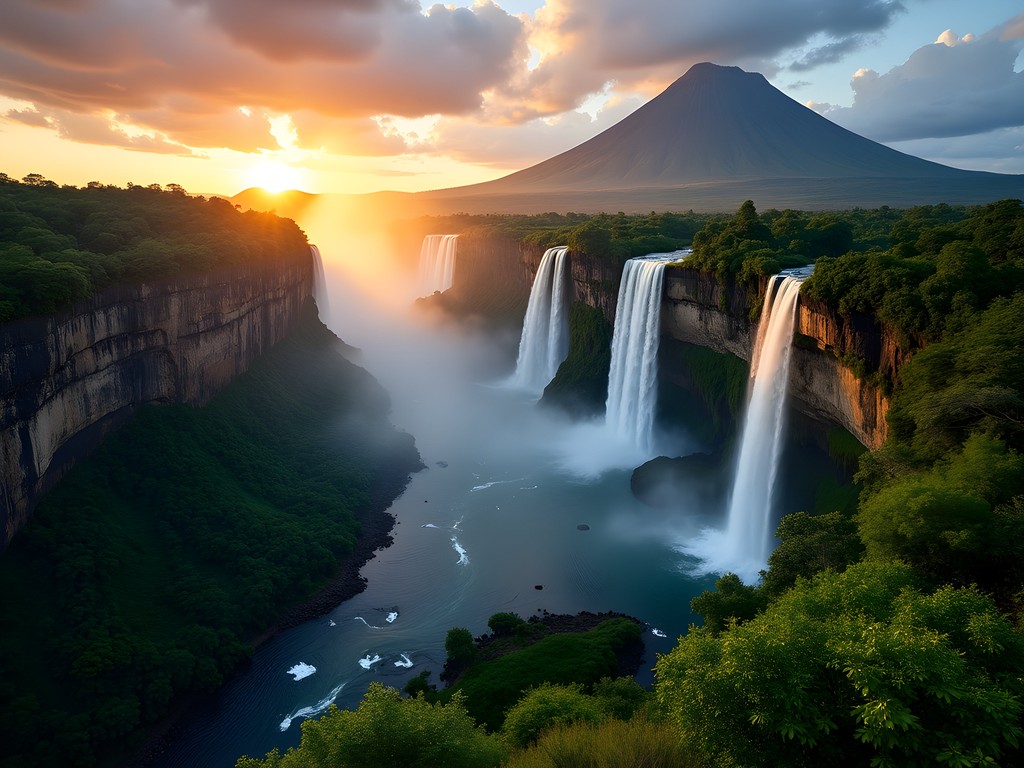
💡 Pro Tips
- Book your trip during the rainy season (June-September) when the falls are at their most dramatic volume
- Arrange specialized photography guides in advance who know the best vantage points
- Pack minimally but comprehensively—every gram matters during the jungle trek
Essential Photography Gear for Angel Falls
The challenging environment of Canaima National Park demands thoughtful gear selection. After multiple visits, I've refined my equipment list to balance comprehensive coverage with practical portability.
A versatile camera system is non-negotiable. My weather-sealed camera has proven invaluable in the humid, often misty conditions around the falls. The weather-sealing provides peace of mind when unexpected rain showers appear (which happens frequently in this microclimate).
Lens selection is critical. I recommend three essential lenses:
- A wide-angle zoom (16-35mm) for capturing the falls' immense scale and surrounding landscape
- A medium telephoto (70-200mm) for isolating sections of the falls and capturing details
- A standard zoom (24-70mm) for versatility during the journey
Filters are absolutely essential for waterfall photography. My neutral density filter kit allows me to achieve those silky-smooth water effects even in bright daylight. A polarizer is equally important to manage reflections and enhance the lush greens of the surrounding jungle.
Beyond camera equipment, consider these environmental challenges:
- Humidity protection: Silica gel packets and airtight storage bags
- Power solutions: Multiple batteries and a solar charger
- Stability: A lightweight carbon fiber tripod that won't sink into muddy terrain
During my last expedition, I experimented with a drone for aerial perspectives, but be aware that permissions are required and weather conditions often make drone photography challenging at best, impossible at worst.
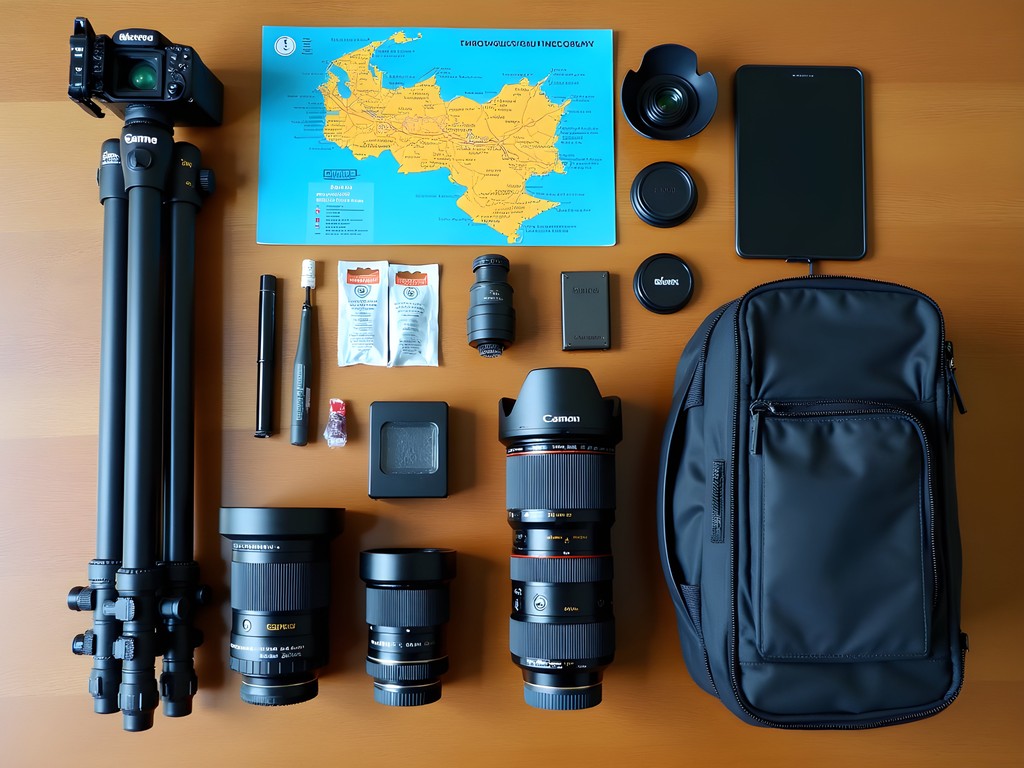
💡 Pro Tips
- Pack twice as many batteries as you think you'll need—charging opportunities are extremely limited
- Use silica gel packets in all equipment bags to combat the extreme humidity
- Consider a lightweight microfiber cloth attached to your strap for quick lens cleaning in misty conditions
Mastering Angel Falls Compositions
Capturing Angel Falls presents a fascinating compositional challenge: how do you frame something so immense while conveying its true scale and grandeur? Through my multiple visits, I've discovered several compositional approaches that consistently yield powerful images.
The Classic Frontal View The most recognizable composition is from the river looking directly at the falls. While this perspective is iconic, it benefits from thoughtful framing. I've found including elements like traditional dugout canoes (curiara) in the foreground creates a sense of scale and cultural context. During my second visit, I positioned myself where the river bends slightly, allowing me to use the S-curve of the water as a leading line toward the falls.
Contextual Landscape One of my most successful images places Angel Falls within its broader context—the ancient tepui landscape. By hiking to elevated viewpoints and using a wide-angle lens, I've captured compositions showing how the falls emerge from the tabletop mountain and plunge into the valley below. This perspective helps viewers understand the geological uniqueness of the region.
Intimate Details While grand vistas are impressive, don't overlook the intimate details. Using a telephoto lens to isolate sections of the falls—particularly where the water transforms into mist before reaching the bottom—creates ethereal images that convey the falls' enormous height. The interplay of light through this mist creates rainbow effects during certain times of day.
Human Element Thoughtfully including people in some compositions provides both scale and emotional connection. During my last visit, I photographed our Pemon guide gazing up at the falls, his silhouette framed against the white water. This single image conveys both scale and the human connection to this sacred place better than any pure landscape shot could achieve.
Remember that Angel Falls' appearance changes dramatically with water volume. During peak flow (rainy season), it's a thunderous torrent; in drier months, it separates into distinct ribbons of water. Both offer compelling photographic opportunities with different compositional considerations.
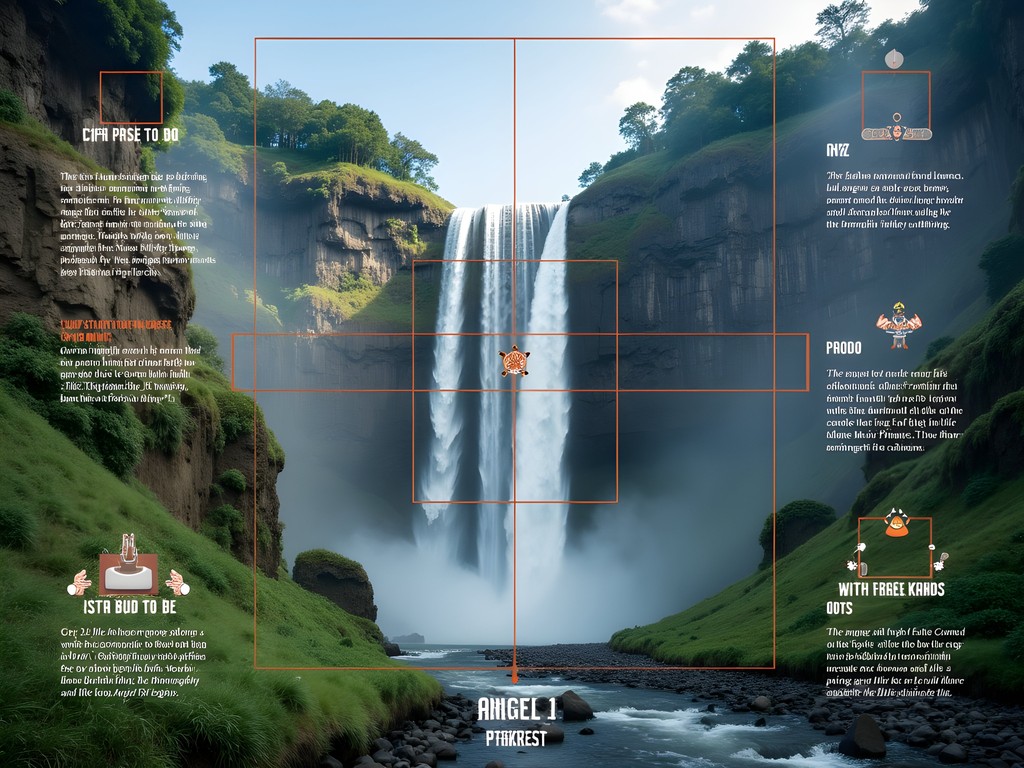
💡 Pro Tips
- Use people, vegetation or boats in your composition to provide a sense of the falls' immense scale
- Experiment with both horizontal and vertical orientations—the latter often better captures the falls' height
- Look for natural frames created by the surrounding jungle foliage
Lighting and Timing Strategies
The lighting conditions at Angel Falls can transform from sublime to challenging within minutes, making timing your photography sessions critical. Having experienced everything from perfect golden hour illumination to torrential downpours that lasted days, I've developed strategies to maximize photographic opportunities regardless of conditions.
Golden Hour Magic During my third expedition, I committed to reaching our viewing position one hour before sunrise. The effort was richly rewarded—as the first light hit the top of the falls while the valley remained in shadow, the water appeared to glow from within. This ethereal quality is nearly impossible to capture at midday. Similarly, late afternoon light creates dramatic side-lighting that emphasizes the texture of the water and surrounding cliffs.
Mist and Atmospheric Conditions Angel Falls creates its own microclimate, with mist often obscuring the view. Rather than seeing this as an obstacle, embrace these atmospheric conditions. Some of my most evocative images show the falls partially veiled in cloud, revealing just enough to create mystery and depth. These conditions work particularly well in black and white photography.
Night Photography Possibilities For the technically adventurous photographer, Angel Falls offers remarkable night photography opportunities. During my last visit, I used my night photography setup with its exceptional low-light performance to capture the falls under moonlight. The results were otherworldly—the water appearing as a silver ribbon against the black tepui. This requires specialized equipment and techniques, but delivers unique images few photographers attempt.
Weather Considerations Venezuela's rainy season (June-September) provides the most dramatic water volume, but also brings greater cloud cover and precipitation. The dry season offers more reliable shooting conditions but less impressive water flow. I've found early June offers the best balance—substantial water volume from early rains, but before the heaviest cloud cover sets in.
Perhaps the most important timing advice I can offer is patience. During my first visit, we experienced three days of constant rain and fog with the falls completely obscured. On the fourth morning, we awoke to perfect conditions with dramatic clouds parting to reveal the falls in golden light. Those who had given up missed the opportunity for truly exceptional images.
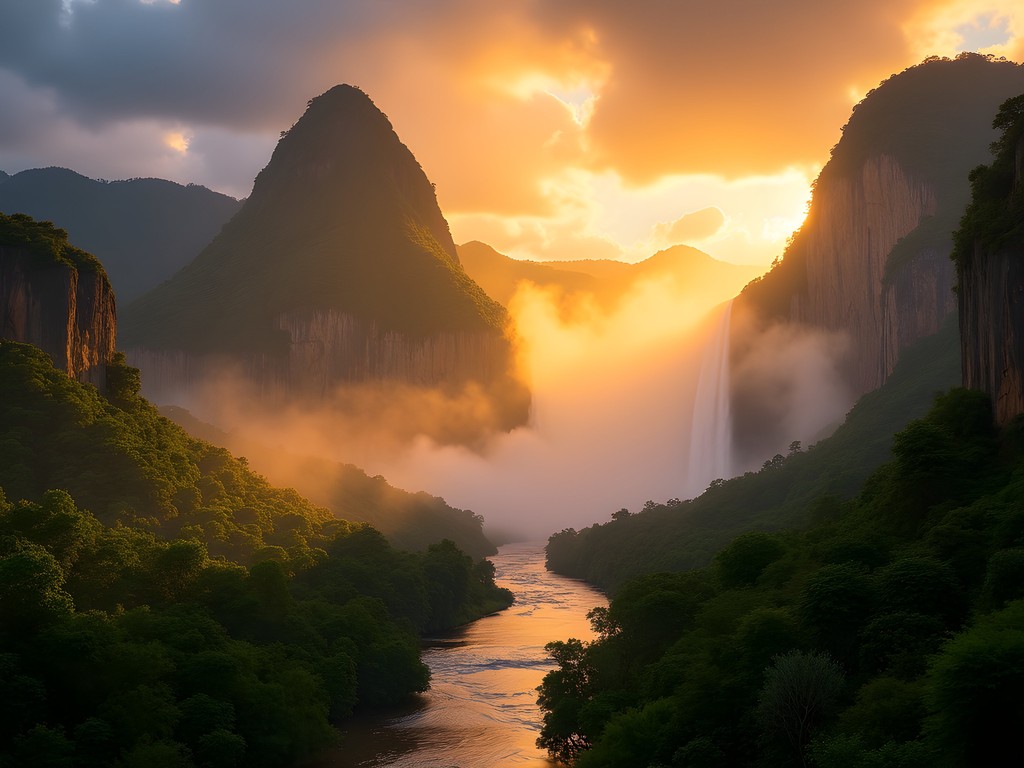
💡 Pro Tips
- Plan to visit the same viewpoints at different times of day—the changing light transforms the scene completely
- During rainy season, be prepared for brief windows of opportunity between weather systems
- Use a weather app with radar to anticipate clearing conditions after rainfall
Technical Challenges and Solutions
Photographing Angel Falls presents several technical challenges that even experienced photographers find daunting. After multiple visits and countless frames, I've developed reliable techniques to overcome these obstacles.
Extreme Dynamic Range Perhaps the greatest technical challenge is managing the extreme contrast between the bright white water and dark surrounding cliffs. During my second expedition, I finally mastered this using exposure bracketing and HDR software for post-processing. Capturing 3-5 bracketed exposures (usually 1-2 stops apart) provides enough data to create natural-looking images that retain detail in both highlights and shadows.
Water Movement and Shutter Speed The artistic decision of how to render water movement significantly impacts the emotional quality of your images. Through experimentation, I've found three shutter speed ranges produce distinctly different effects at Angel Falls:
- 1/1000 sec or faster: Freezes individual water droplets, emphasizing power and energy
- 1/15 - 1/60 sec: Creates a partial silky effect while maintaining some texture
- 1-4 seconds: Transforms the falls into ethereal, cloud-like formations
I recommend experimenting with all three approaches, as each conveys a different feeling and perspective of the falls.
Stabilization in Challenging Conditions The viewing platforms and trails around Angel Falls often subject photographers to vibration from wind, moving people, or unstable surfaces. Beyond using a sturdy tripod, I've found these techniques essential:
- Hang your camera bag from the tripod center column for added stability
- Use your camera's electronic first curtain shutter to minimize vibration
- Employ a remote trigger or 2-second delay to avoid camera shake
- When shooting from boats, use image stabilization and faster shutter speeds
Protecting Equipment The microclimate around Angel Falls creates constant humidity and occasional mist that can quickly fog lenses and potentially damage equipment. I keep a weather protection system readily accessible for sudden weather changes. Additionally, I've found keeping silica gel packets in my camera bag and regularly allowing equipment to air out in the sun (when available) helps manage moisture issues.
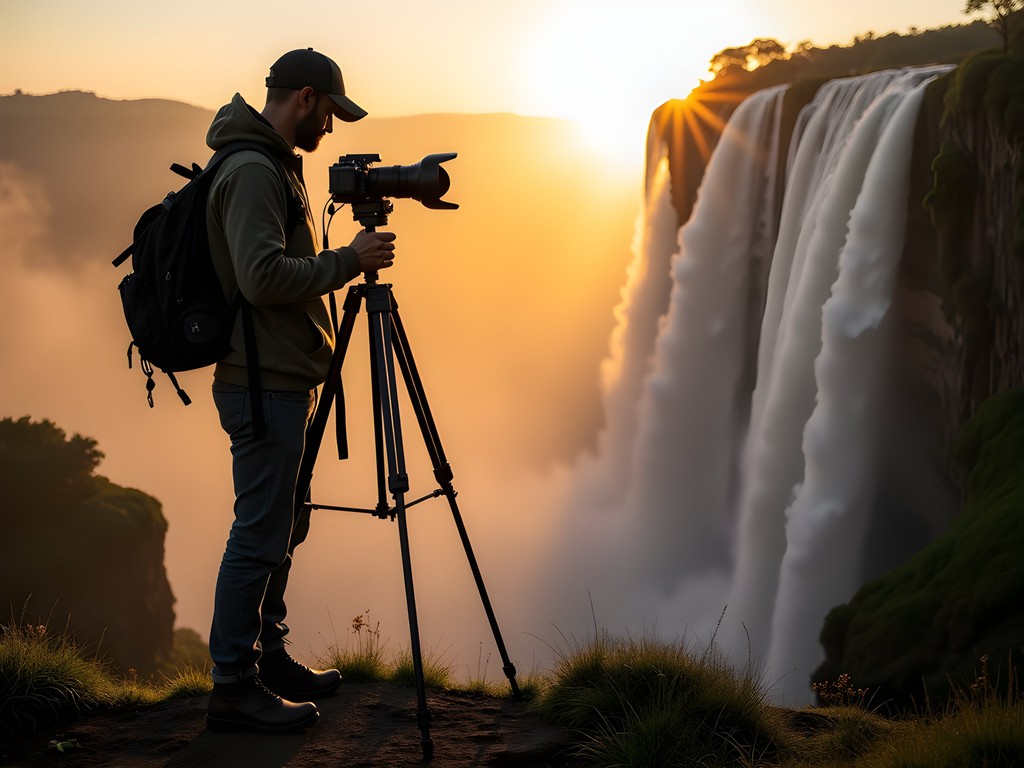
💡 Pro Tips
- Always check your histogram to ensure you're capturing full dynamic range—the bright white water often tricks camera meters
- Use a microfiber cloth attached to your wrist strap for quick lens cleaning when mist accumulates
- Consider a graduated ND filter when shooting during midday to balance sky and foreground exposure
Cultural Sensitivity and Environmental Ethics
Throughout my career in luxury hospitality and travel photography, I've developed a deep appreciation for the cultural and environmental contexts of the destinations I document. Angel Falls exists within the ancestral lands of the Pemon people, who know it as 'Kerepakupai Merú' (waterfall of the deepest place). This understanding should inform our approach as photographers.
During my visits, I've learned the importance of working with Pemon guides not just for their practical knowledge but to gain permission and insight into their relationship with this sacred place. On my third expedition, our guide Carlos explained how the falls feature in Pemon creation stories—context that transformed how I composed my images to honor this cultural significance.
Environmental considerations are equally important. The fragile ecosystem surrounding Angel Falls faces pressure from increased tourism. As photographers, we have a responsibility to minimize our impact:
- Stay strictly on established trails to prevent erosion and vegetation damage
- Pack out all equipment, batteries, and waste
- Respect wildlife by maintaining distance and using telephoto lenses rather than approaching animals
- Consider how sharing your images might influence others to visit, and use your platform to promote responsible tourism
I've also found that slowing down and spending more time in fewer locations yields both better photographs and a lighter environmental footprint. Rather than rushing between viewpoints, I now spend hours observing how light interacts with the falls from a single vantage point—a practice that has deepened my connection to this remarkable place while producing more thoughtful images.
Finally, consider how your photographs might benefit local communities. I make it a practice to send prints back to the lodges and guides who assisted me, and contribute images to conservation organizations working to protect Canaima National Park. Photography can be a powerful tool for conservation when approached with intention and respect.
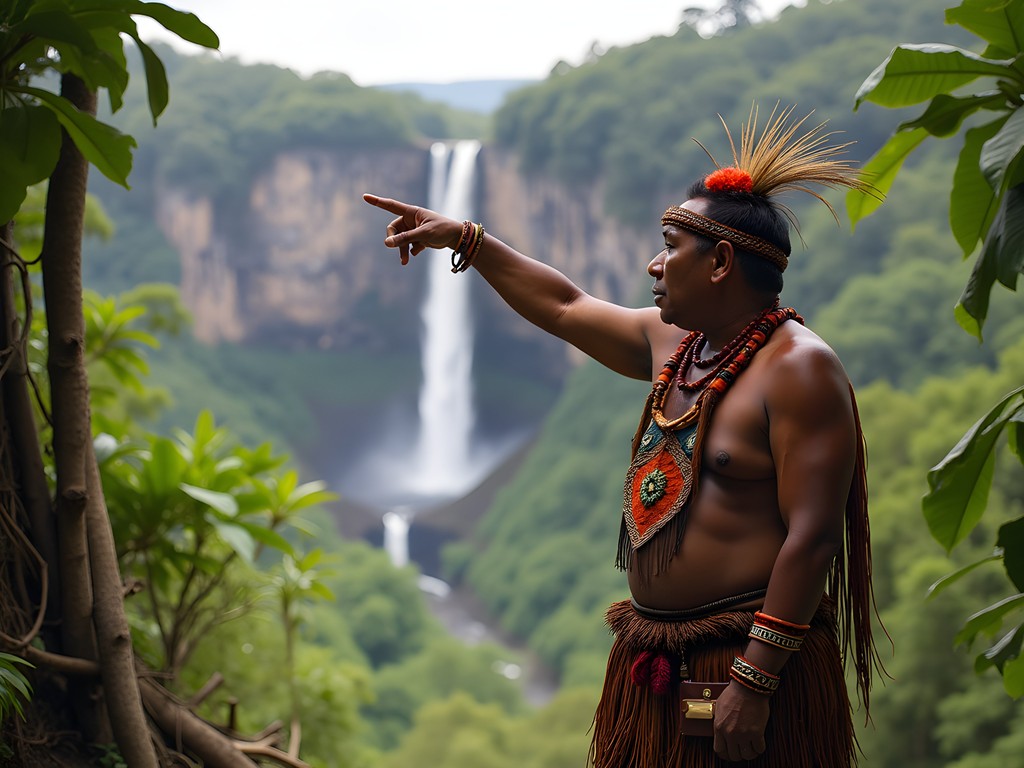
💡 Pro Tips
- Learn basic phrases in Spanish and, if possible, Pemon language to show respect to local guides
- Ask permission before photographing indigenous people or cultural practices
- Consider donating a percentage of any commercial sales of your Angel Falls images to conservation efforts
Final Thoughts
Standing before Angel Falls for the final morning of my most recent expedition, camera in hand as the first light illuminated its thundering cascade, I reflected on how this natural wonder continues to humble me both as a photographer and a traveler. No matter how advanced our equipment or refined our techniques, some experiences will always transcend perfect documentation—and perhaps that's exactly as it should be. The challenge of photographing Angel Falls isn't just technical but philosophical: how do we honor through our images what can never be fully captured? The answer, I believe, lies in approaching this magnificent place with equal parts preparation and reverence, technical skill and open-hearted wonder. Whether you're planning your first visit or returning to refine your portfolio, I hope these insights serve your journey. The tepuis have stood for millions of years; Angel Falls has flowed for thousands. Our photographs are merely fleeting glimpses of something timeless—and in that humbling recognition lies the true art of waterfall photography.
✨ Key Takeaways
- Timing is everything—visit during June-September for maximum water flow and plan shoots around golden hour
- Technical preparation with the right filters, tripod, and weather protection is essential for success
- Understanding composition techniques specific to massive waterfalls will dramatically improve your images
- Approach photography with cultural sensitivity and environmental ethics as your foundation
📋 Practical Information
Best Time to Visit
June to September (rainy season)
Budget Estimate
$3,000-$5,000 USD for a week-long expedition
Recommended Duration
7-10 days minimum
Difficulty Level
Challenging
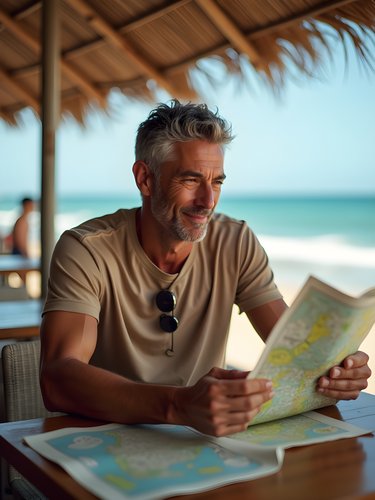








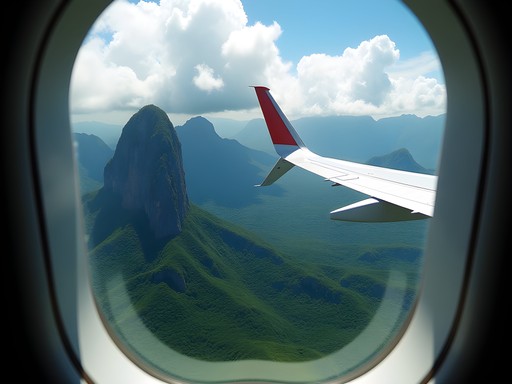


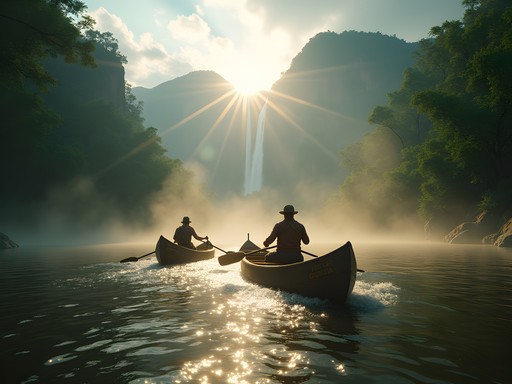




Comments
Timothy Jenkins
Brilliant guide, Brandon! I visited Angel Falls last year and wish I'd had these composition tips beforehand. The section about shooting during different weather conditions is spot on - my best shots came after a brief rain shower when the light hit the falls at about 4pm. One additional tip for readers: the humidity can wreak havoc on camera equipment. I double-bagged everything in silica-packed dry bags and still had condensation issues. Taking your gear out gradually in stages helps with the temperature/humidity adjustment. The journey to the falls is almost as photogenic as the falls themselves - those tepui formations from the flight in are otherworldly!
Brandon Tanaka
Great point about the humidity, Timothy! I should have emphasized that more. Those tepuis are indeed incredible - almost like something from a lost world. Did you get to stay overnight at the base camp?
Timothy Jenkins
Yes, three nights at the base camp! That midnight shot with stars you captured still eludes me though - clouds rolled in every night of my stay. Just means I'll have to go back!
journeystar
The humidity tip is super helpful! How much did the whole trip cost you guys if you don't mind sharing?
globephotographer
I'm planning to visit in January but I'm a total beginner with photography. Would a smartphone camera be enough or do I really need a DSLR for decent shots?
Timothy Jenkins
Modern smartphones can actually capture impressive shots of Angel Falls, especially the latest models with good dynamic range. That said, the extreme contrast between the bright sky and shadowed cliff face is challenging. If possible, bring a travel tripod even for your phone - it'll make a huge difference for those sunrise/sunset shots Brandon mentions!
globephotographer
Thanks Timothy! That's reassuring. I have the latest iPhone so I'll look into a small tripod. Any apps you recommend for waterfall photography?
Brandon Tanaka
Jumping in here - definitely try an app that lets you manually control shutter speed. That's key for getting that silky water effect! And don't forget a waterproof case - the spray zone is intense!
journeystar
Those waterfall shots are absolutely breathtaking! The one with the morning mist is like something from a dream. Definitely adding Angel Falls to my bucket list now!
Brandon Tanaka
Thanks journeystar! That morning mist shot was worth waking up at 4am for. Hope you make it there someday!
lens_hunter
That shot with the rainbow is absolute perfection!
adventurejunkie
How difficult was the hike to get there? I'm planning a trip but worried about carrying all my camera gear that distance.
Brandon Tanaka
The hike from the camp to the base viewpoint is moderate - about 1 hour each way on uneven terrain. I'd recommend packing only essential gear and a good camera backpack with waist support. The porters can help with some equipment if needed!
roamadventurer
I did this hike with just my phone and a small point-and-shoot! Definitely doable even if you're not super fit.
travelwithsandra
These photos are incredible! 😍
photogeek22
Great post! I visited Angel Falls last year and found that a polarizing filter made a huge difference with the water reflections. Highly recommend it!
hikerpete
Going there in November! Any tips for protecting camera gear during the boat ride to the falls? Heard it can get pretty wet.
Brandon Tanaka
Definitely bring a good dry bag! The boat spray can be intense, especially during the rainy season. I double-bagged my gear and kept it sealed until we reached each shooting location.
hikerpete
Thanks for the tip! Will definitely pack a couple of dry bags.
Jean Wells
Brandon, excellent technical breakdown of the challenges photographing Angel Falls presents. I visited in 2023 and found the extreme contrast between the bright sky and shadowed cliff face particularly difficult to manage. Your suggestion about bracketing exposures saved several of my shots. I'd add that having a microfiber cloth specifically for wiping mist off lenses is absolutely essential - I went through three per day! The section on timing was spot on - that golden hour window is remarkably short in the canyon. Did you experiment with any long exposure techniques from the base pool viewpoint?
Brandon Tanaka
Thanks Jean! Yes, I did several 2-3 second exposures from the base pool - there's one in the gallery that shows that silky water effect. The challenge was keeping the camera steady on those slippery rocks!
Jean Wells
I know exactly what you mean about those rocks! I ended up using my travel tripod with spiked feet which helped tremendously. Your silky water shot has beautiful tonality.
roamadventurer
Those shots are absolutely stunning! The way you captured the mist against the morning light is magical. Adding Angel Falls to my bucket list right now!
Brandon Tanaka
Thanks so much! The morning light there is truly special - worth the early wake-up call!
roamadventurer
What time did you have to get up to catch that perfect light?
Brandon Tanaka
We were up by 4:30am to hike to the viewpoint. First light hit around 6am. Brutal but worth it!
Venture X
Premium card with 2X miles, $300 travel credit, Priority Pass